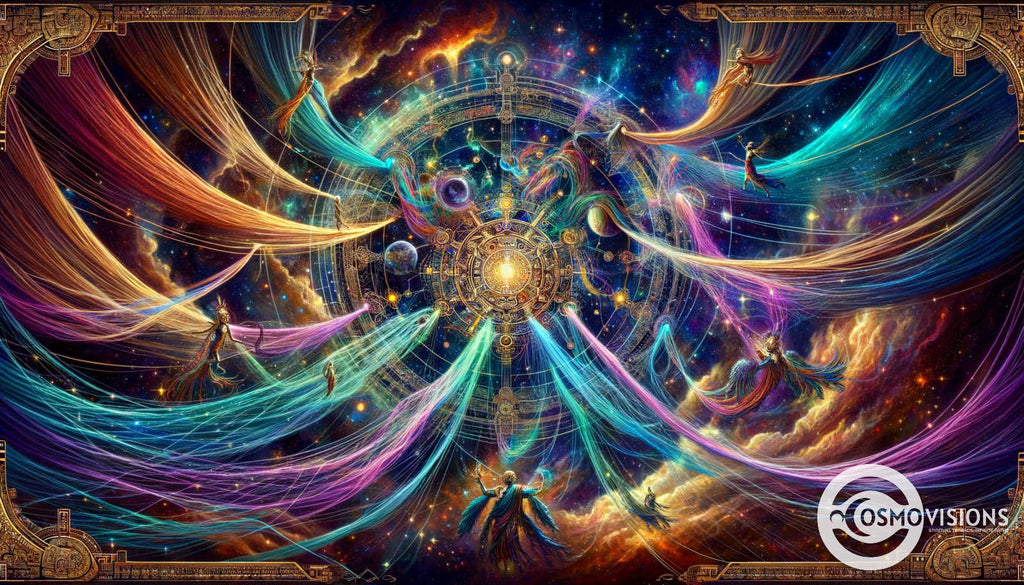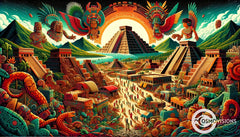Becoming Weaving: An Introduction to the Textile Metaphysics of the Aztecs
Posted by Massimiliano Geraci

Imagine the cosmos not as a vast expanse of galaxies and stars but as an intricate tapestry, a grand weaving-in-progress. This is not a concept from a far-flung science fiction universe but a glimpse into the profound metaphysical worldview of the ancient Aztecs. Instead of viewing their universe as a static entity, they perceived it as a dynamic, ever-unfolding fabric meticulously crafted by the divine forces of the cosmos. This article will introduce you to the intricate web of Aztec metaphysics, where the cosmos is seen as a grand weaving-in-progress. It will also pave the way for a deeper exploration of two central concepts in Aztec metaphysics, Teotl and Pantheism, in the following articles of this series.
The Intricate Web of Aztec Metaphysics
In the Aztec worldview, the cosmos was not merely a physical realm or an abstract philosophical concept. It was a complex tapestry, intricately woven by metaphysical threads. This worldview was deeply rooted in their cultural and spiritual practices and was articulated through a key principle known as ‘nepantla’.
What is nepantla? In Aztec metaphysics, nepantla is a Nahuatl term signifying a middle or transitional space, a realm of change, process, and becoming. It is here that opposing forces meet, interact, and generate new realities. Nepantla is the weaver’s loom in the grand tapestry of existence, a space where the intricate dance of creation and transformation unfolds.
The Dynamic Cosmos: Motion-Change in Aztec Metaphysics
The Aztecs conceived their cosmos as a dynamic entity, constantly in motion and change. This dynamism was characterized by three types of motion-change - Olin, Malinalli, and Nepantla.
Olin represents cyclical motion, a rhythmic oscillation akin to the cycle of day and night or the changing seasons. Malinalli embodies twisting or spiraling motion, much like a whirlwind or a coiling serpent, evoking the dynamic interplay of energies in the cosmos. Nepantla, the most fundamental of the three, encapsulates the transformative motion-change where opposing forces engage in a dynamic interplay, akin to the weaver’s hand guiding the threads to create a coherent pattern.
These motion-changes are not abstract concepts but vital forces that shape the cosmos, explaining its continuous becoming, ordering, and diversity. What does this mean? It means that the cosmos, in the Aztec worldview, is not a static entity but a dynamic, ever-evolving fabric of reality.

Weaving the Cosmos: The Nepantla Process
In the grand tapestry of the cosmos, the Nepantla process acts like the weaver’s hand, constantly interlacing threads of existence to create a dynamic, ever-evolving fabric of reality. This process, much like the weaving of a physical tapestry, involves the intricate interplay of threads (energies, forces, entities) to create a coherent and meaningful pattern.
The Nepantla process interweaves order and disorder, being and nonbeing, life and death, in a continuous process of transformation, creating a reality that is ever-changing and ever-becoming. It is within this intricately woven cosmic tapestry that the drama of existence unfolds, with every entity playing its part in the grand cosmic narrative.
The Fifth Sun-Earth Age: A Unique Nepantla-Process
The Aztec cosmos is divided into five Sun-Earth Ages, each characterized by a different cosmic pattern. However, the Fifth Sun-Earth Age stands out for its unique weaving pattern.
In what way is the Fifth Sun-Earth Age unique? In this age, the cosmos is weaved through a Nepantla process that involves the Fifth Sun as the weft (horizontal threads) and the Tonalpohualli and Xiuhpohualli (two primary Aztec calendars) as the warp (vertical threads). This unique weaving pattern represents the intricate interplay of forces and energies that shape the cosmos in this age. In this perspective, the cosmos is not a collection of static entities but a dynamic, ever-evolving fabric of interconnected forces and energies.
The Art of Weaving and the Act of Creation
The act of weaving in Aztec culture was not merely a craft but a sacred process that mirrored the divine act of creation. Like the gods who wove the cosmos, the Aztec weavers wove threads to create intricate fabrics, each thread and pattern imbued with symbolic meaning.
Intriguingly, the act of weaving was also intimately linked to sexual intercourse, another act of creation. Both these root metaphors – weaving and sexual intercourse – played a central role in Aztec metaphysics, illustrating the cosmic process of creation and transformation. In the loom of the cosmos, every warp and weft, every union of opposites, brings new creations and realities.

Weaving the Future: A Look Ahead
In this series, we will further explore these fascinating concepts, diving deep into the metaphysical threads that weave the intricate tapestry of the Aztec cosmos. The next article will focus on ‘Teotl’, the all-encompassing divine force and the central principle of Aztec metaphysics. We will examine its characteristics, its role in the Aztec worldview, and the scholarly interpretations that have shaped our understanding of this concept.
Following that, we will delve into ‘Pantheism’, another central tenet of the Aztec worldview. We will discuss how the Aztecs perceived divinity as inherent in all aspects of the cosmos and how this perspective influenced their spiritual practices, societal structures, and artistic expressions.
Finally, we will return to the concept of ‘Nepantla’, this time exploring it in the context of the Fifth Sun-Earth Age. We will examine how the Aztecs believed this era to be a unique Nepantla process, with the cosmos being weaved through a complex interplay of forces and energies.
Through this series, we aim to unravel the profound metaphysical insights of the Aztecs, bringing their ancient wisdom to the modern reader and illuminating the intricate web of connections that link us to the cosmos.






















